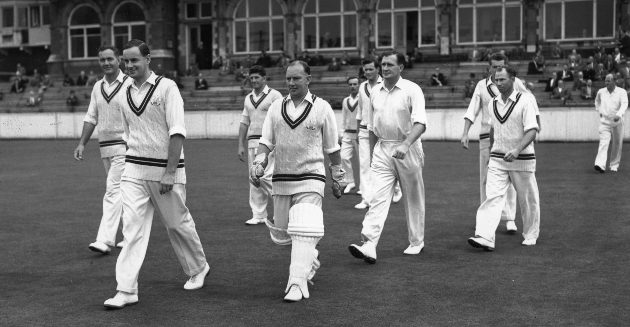As Surrey prepare for the final stages of the LV= Insurance County Championship, Richard Spiller looks back 65 years to when one of the club’s most illustrious eras was coming to a close, claiming an unprecedented seventh straight County Championship title on August 29, 1958.
As Surrey prepare for the final stages of the LV County Championship, Richard Spiller looks back 65 years to when one of the club’s most illustrious eras was coming to a close, claiming an unprecedented seventh straight County Championship title on August 29, 1958.
No team have dominated English cricket in the way Surrey monopolised the County Championship in the 1950s, winning it seven times in a row. When Stuart Surridge was appointed captain for the 1952 campaign, he predicted his side would win for the next five years.
He was wrong but in the best way possible. Surridge supervised the collection of five titles before handing over to Peter May in 1957, his successor having already been England skipper for two years by that stage.
And although May was frequently away on international duty, often joined by spinners Jim Laker and Tony Lock – plus more sporadic appearances from the likes of Peter Loader, Arthur McIntyre and Ken Barrington – he could rely on a phalanx of high quality and experienced players to keep the side motoring along.
In 1957 they stormed to their sixth success, finishing 94 points clear of runners-up Northamptonshire on the back of winning 21 out of 28 matches.
They made it seven out of seven the following summer, Wisden reporting that “the invincible march of Surrey continued” despite the usual absences and Alec Bedser – whose England days were now behind him – being kept out of action until July by pneumonia and then having to be nursed. Not only was his command of swing and seam missed but so was his capacity to deputise for May, leaving wicketkeeper McIntyre to lead out the side.
It seemed to make little difference early on, Surrey winning their first five matches – three by an innings – to lead the table. Then came a sticky patch which included a heavy defeat by Yorkshire at Bramall Lane, Hampshire taking over at the top in late June and holding on to the summit until August 22.
But as their south-western neighbours stuttered nervously at the thought of landing the Championship for the first time, Surrey sniffed success again and launched a run of six wins from nine which included two trouncings of Middlesex to wrap up that unprecedented seventh triumph in a row on August 29.
May’s reputation as England’s finest post-war batter was heightened by the way he stroked 1,274 Championship runs at 55 in just 14 Championship games, much valuable work done too by Bernard Constable (887 at 32), David Fletcher (728 at 26) and Micky Stewart (968 at 25). Left-arm spinner Lock’s 114 victims at 12 and off-spinner Laker’s 93 at 13 dominated the attack, speedster Loader (79 at 17) another key performer.
It had been harder work than 1957, for sure, the final points tally of 212 a reduction of 100 from the previous year, finishing 26 points clear.
The weather had much to do with that. A decade known for its damp and chilly summers reached a nadir in 1958 and the touring New Zealanders lost 174 playing hours as they moved around the country.
There were signs that an invincible squad was starting to fray at the edges, Stewart recalling that a team seemingly at its peak 12 months earlier was now spying sporting mortality.
Confirmation that an era was ending came soon. McIntyre, whose keeping to Bedser and the spinners led a remarkable group of catchers, retired at the end of the season, his England caps limited to three by the presence of Godfrey Evans. He took over as coach from Andrew Sandham, one of the county’s most prolific run-scorers in the first half of the century, who in turn succeeded Herbert Strudwick, who had been among his county and country’s finest wicketkeepers before becoming scorer.
“Struddy” had made his debut for the county in 1900 and his retirement gift from the players and staff was a television set.
Midway through that season had come news from Switzerland of the death of former Surrey and England captain Douglas Jardine, aged 57, his health having never recovered from catching ‘tick fever’ on a visit to Africa the previous year.
His accomplishments as a batter – playing 22 Tests between 1928 and 1934 for England, skipper in 15 of them – were overshadowed by leading the Bodyline Ashes tour in 1932-33, when an attack led by Harold Larwood and Bill Voce were accused of intimidating the Australians with short-pitched fast bowling aimed at the body. It was by no means just the hosts who felt it was against the spirit of the game. Jardine’s involvement with the game was cut short amid the recriminations which followed but his own bravery, facing down a pacy West Indian attack in 1933, was never in doubt. He captained Surrey in 1932 and 1933.
The 1958 Oval Test
You could have forgiven New Zealand for a feeling of dread as they approached the Test at The Oval at the end of August 1958.
They had lost the first four Tests of the series – not helped by such misfortune with the weather – and their two previous trips to The Oval that summer both resulted in defeats by an innings at the hands of Surrey.
This time the awful weather came to their rescue as only 12 hours of play proved possible and was almost entirely confined to the first and last days. The third and fourth were total washouts.
The Kiwis slumped to 132-8 on day one before tailender Alex Moir’s 41 lifted them to 161 all out. There were two wickets apiece for Fred Trueman, Trevor Bailey and Tony Lock.
England openers Peter Richardson and Arthur Milton started their partnership on the first evening and were still together, thanks to the rain, on the final morning despite only adding 39. New Zealand’s bowlers enjoyed the moist conditions on the final day by leaving England in trouble at 125-6 before Trueman hit hard for his unbeaten 39.
May declared at 219-9, a lead of 68, giving his bowlers just under three hours to claim a whitewash, but they were held off by John Reid’s classy 51no and time ran out at 91-3.
Surrey’s strength was reflected in the winter’s touring party to defend the Ashes as May was joined in the touring party by Loader, Laker and Lock. A greater surprise was the inclusion as second wicketkeeper of Roy Swetman, McIntyre’s deputy and now identified as the long-term successor to Evans in the international side. Also present was Raman Subba Row, who had left Surrey to captain Northamptonshire, reminding former colleagues of his ability by scoring 300 at The Oval in June.
Laker had been ignored for the previous tours to Australia – in 1950-51 and 1954-55 – but his exploits in the 1956 Ashes series, which included taking 19 wickets in the Old Trafford Test, made him an absolute certainty this time. Yet a row with skipper May during Surrey’s match against Kent in mid-July came close to seeing him out of the trip until Denis Compton stepped in to smooth over the dispute.
What was regarded as one of the strongest England sides to ever leave these shores proved to be nothing of the sort. Having established themselves as the best team in the world by going unbeaten since 1950-51, they were crushed 4-0 by Richie Benaud’s men on a tour beset by injuries and controversy.
What else happened in 1958?
When sport moves from the back pages to the front, it is rarely good news.
Tragically that was the case on February 6, 1958, when a plane carrying the Manchester United team on their way back from a European Cup match in Belgrade crashed as it attempted – for the third time – to take off on a freezing runway in Munich. It decimated the Busby Babes, eight United players being among 23 fatalities while two others never played again.
Recovering from the ravages of the Second World War had taken Britain much of the 1950s, some rationing continuing until well into the decade. The empire, which once spread across much of the globe, was steadily decreasing and an ill-fated bid to recapture control of the Suez Canal from Egypt in 1956 had weakened Britain’s position further, also forcing the resignation of Sir Anthony Eden as Prime Minister.
His successor, Harold Macmillan, set about repairing relationships, not least with the United States given the pressure they had exerted in forcing Britain to pull out of Suez.
Despite the resignations of three ministers over spending levels, dismissed by the PM as “a little local difficulty’, the man dubbed by a cartoonist as ‘Supermac’ was well into his stride and on the way to an election the following year which would stretch his majority from 60 to 100 seats.
The European Economic Community came into being, much debate being had about whether the UK should join or stay aloof. Not much change there then.
Nikita Khrushchev consolidated his hold on power in the post-Stalin Soviet Union by becoming Premier. The grip on eastern Europe, with the cold war at its height, does not lessen with the leaders of the Hungarian Uprising two years earlier being executed.
Charles de Gaulle, leader of the Free French in the Second World War, emerged from retirement to quell the chaos in his country and was elected president of the new Fifth Republic.
Queen Elizabeth II announced that her eldest son and heir, Charles, has been given the title of Prince of Wales.
Pope Pius XII died in 1958 and was replaced in the Vatican by Pope John XXIII.
At the British Empire and Commonwealth Games, staged in Cardiff, England finished top of the medals table, just ahead of Australia.
Wolverhampton Wanderers won the 1958 Football League Championship title, finishing five points ahead of Preston North End. Bolton Wanderers beating Manchester United 2-0 to claim the FA Cup. The World Cup, staged in Sweden from June 8-29, saw Brazil beat the hosts 5-2 in the final.
Ashley Cooper defeated fellow Australian Neale Fraser 3-6 6-3 6-4 13-11 to win the Wimbledon men’s singles title, America’s Althea Gibson successfully defending the women’s title by overcoming Briton Angela Mortimer 8-6 6-2 and adding the doubles title alongside Maria Bueno. Only defeat in the mixed doubles final deprived her of a treble.
Peter Thomson, having claimed a hat-trick of Open titles in 1954-56, returned to make it four in a 36-hole play-off against American Dave Thomas at Lytham St Annes.
Mike Hawthorn became the Formula One champion, just ahead of Stirling Moss, British drivers occupying the leading five places. One of them, Peter Collins, was among the four drivers killed in action during the season. And Hawthorn himself perished three months after his triumph after an accident on the A3 Guildford bypass.


















